Financial Reporting: IASB Framework, Objectives, and Concepts
VerifiedAdded on 2020/06/05
|7
|1347
|54
Report
AI Summary
This report provides a comprehensive overview of financial reporting, grounded in the International Accounting Standards Board (IASB) framework. It begins by addressing the fundamental objectives of financial reporting, emphasizing its role in providing financial information to investors, lenders, and creditors for informed decision-making. The report delves into the core concepts, including predictive and confirmatory value, and the importance of faithful representation. It also examines the enhancing qualities that improve the usefulness of financial statements, such as comparability, verifiability, timeliness, and understandability. Furthermore, the report addresses key elements like recognition, measurement, and disclosure requirements. It explains the going concern concept, monetary unit, periodicity, and the accrual basis of accounting, providing a holistic understanding of financial reporting principles. The report is well-supported by relevant references.

Financial
Table of Contents
Table of Contents
Paraphrase This Document
Need a fresh take? Get an instant paraphrase of this document with our AI Paraphraser
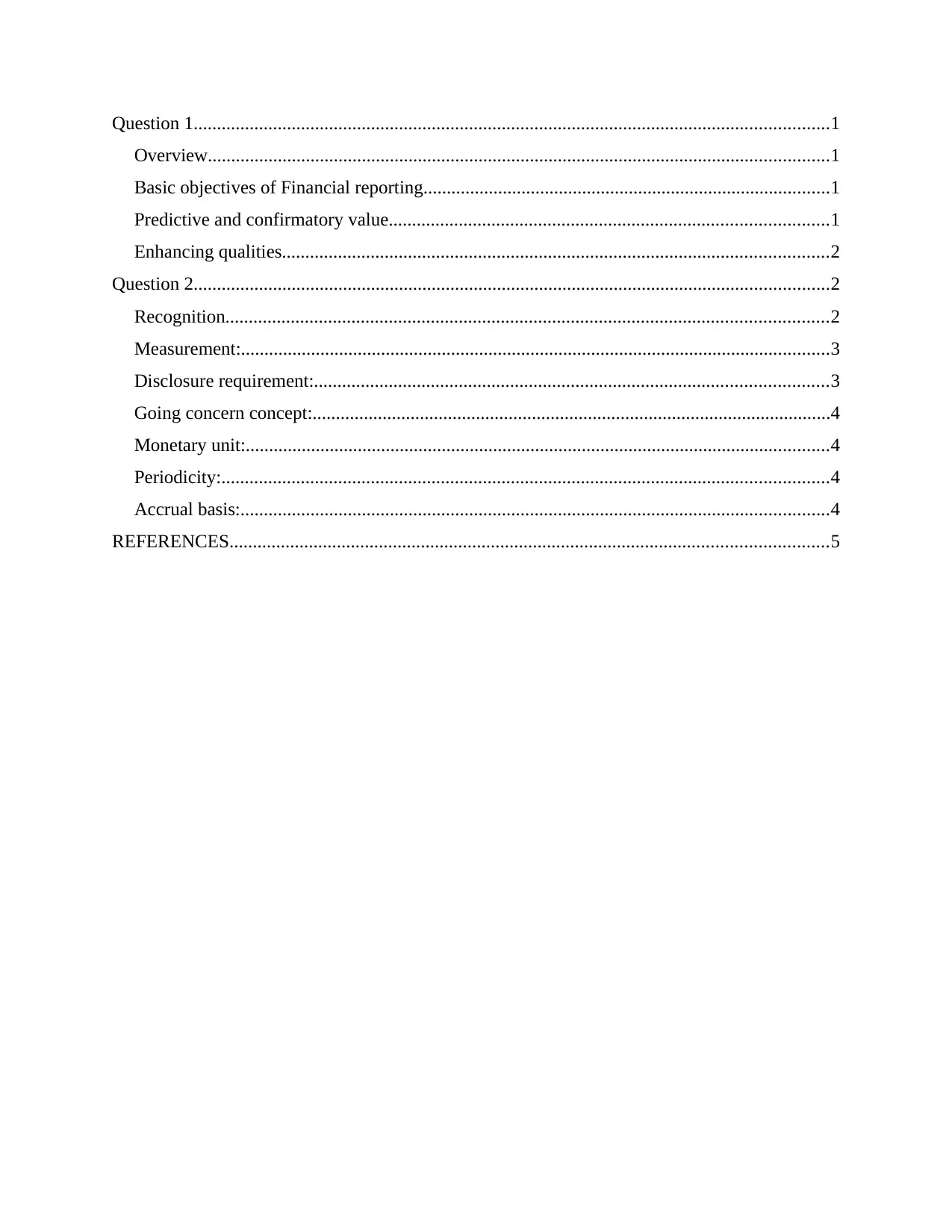
Question 1........................................................................................................................................1
Overview.....................................................................................................................................1
Basic objectives of Financial reporting.......................................................................................1
Predictive and confirmatory value..............................................................................................1
Enhancing qualities.....................................................................................................................2
Question 2........................................................................................................................................2
Recognition.................................................................................................................................2
Measurement:..............................................................................................................................3
Disclosure requirement:..............................................................................................................3
Going concern concept:...............................................................................................................4
Monetary unit:.............................................................................................................................4
Periodicity:..................................................................................................................................4
Accrual basis:..............................................................................................................................4
REFERENCES................................................................................................................................5
Overview.....................................................................................................................................1
Basic objectives of Financial reporting.......................................................................................1
Predictive and confirmatory value..............................................................................................1
Enhancing qualities.....................................................................................................................2
Question 2........................................................................................................................................2
Recognition.................................................................................................................................2
Measurement:..............................................................................................................................3
Disclosure requirement:..............................................................................................................3
Going concern concept:...............................................................................................................4
Monetary unit:.............................................................................................................................4
Periodicity:..................................................................................................................................4
Accrual basis:..............................................................................................................................4
REFERENCES................................................................................................................................5
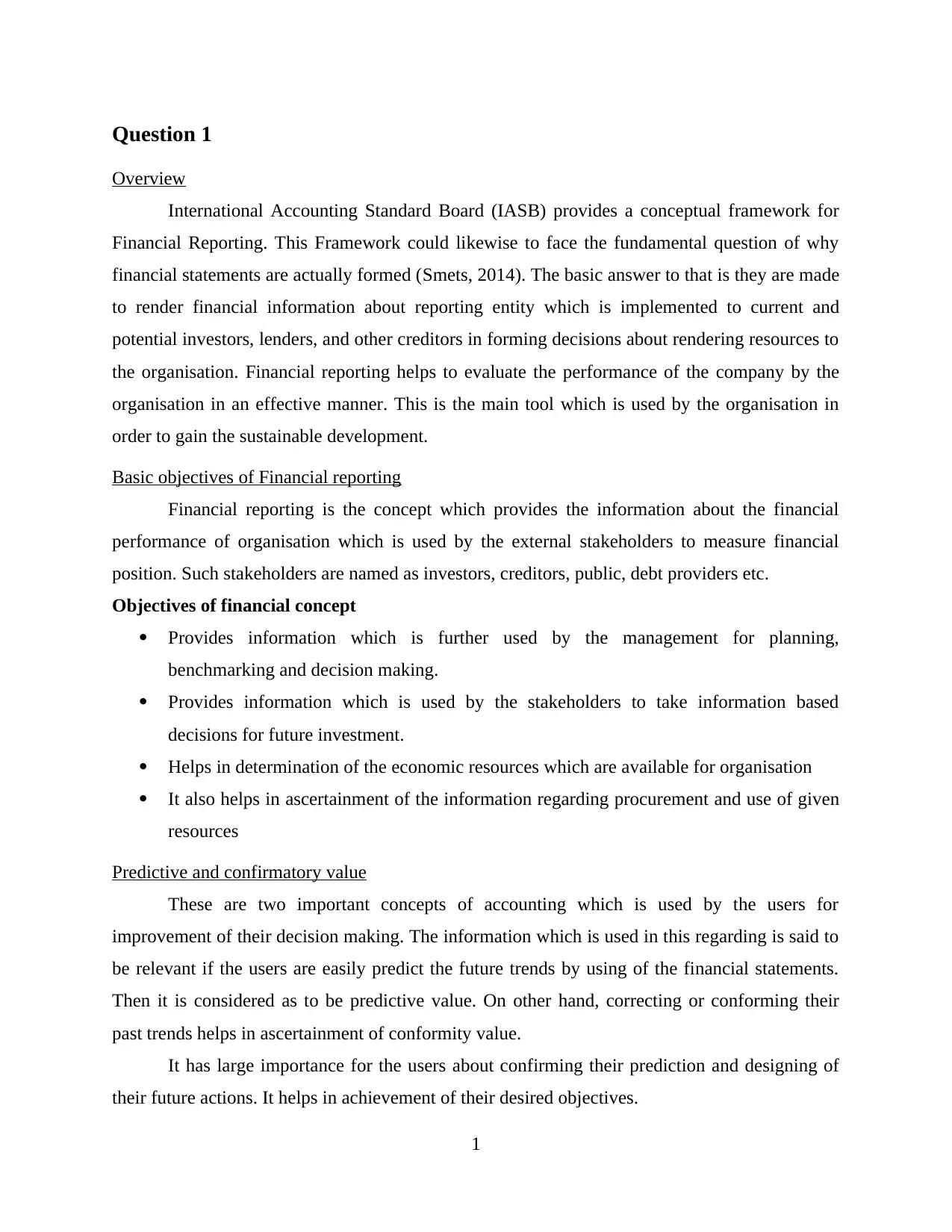
Question 1
Overview
International Accounting Standard Board (IASB) provides a conceptual framework for
Financial Reporting. This Framework could likewise to face the fundamental question of why
financial statements are actually formed (Smets, 2014). The basic answer to that is they are made
to render financial information about reporting entity which is implemented to current and
potential investors, lenders, and other creditors in forming decisions about rendering resources to
the organisation. Financial reporting helps to evaluate the performance of the company by the
organisation in an effective manner. This is the main tool which is used by the organisation in
order to gain the sustainable development.
Basic objectives of Financial reporting
Financial reporting is the concept which provides the information about the financial
performance of organisation which is used by the external stakeholders to measure financial
position. Such stakeholders are named as investors, creditors, public, debt providers etc.
Objectives of financial concept
Provides information which is further used by the management for planning,
benchmarking and decision making.
Provides information which is used by the stakeholders to take information based
decisions for future investment.
Helps in determination of the economic resources which are available for organisation
It also helps in ascertainment of the information regarding procurement and use of given
resources
Predictive and confirmatory value
These are two important concepts of accounting which is used by the users for
improvement of their decision making. The information which is used in this regarding is said to
be relevant if the users are easily predict the future trends by using of the financial statements.
Then it is considered as to be predictive value. On other hand, correcting or conforming their
past trends helps in ascertainment of conformity value.
It has large importance for the users about confirming their prediction and designing of
their future actions. It helps in achievement of their desired objectives.
1
Overview
International Accounting Standard Board (IASB) provides a conceptual framework for
Financial Reporting. This Framework could likewise to face the fundamental question of why
financial statements are actually formed (Smets, 2014). The basic answer to that is they are made
to render financial information about reporting entity which is implemented to current and
potential investors, lenders, and other creditors in forming decisions about rendering resources to
the organisation. Financial reporting helps to evaluate the performance of the company by the
organisation in an effective manner. This is the main tool which is used by the organisation in
order to gain the sustainable development.
Basic objectives of Financial reporting
Financial reporting is the concept which provides the information about the financial
performance of organisation which is used by the external stakeholders to measure financial
position. Such stakeholders are named as investors, creditors, public, debt providers etc.
Objectives of financial concept
Provides information which is further used by the management for planning,
benchmarking and decision making.
Provides information which is used by the stakeholders to take information based
decisions for future investment.
Helps in determination of the economic resources which are available for organisation
It also helps in ascertainment of the information regarding procurement and use of given
resources
Predictive and confirmatory value
These are two important concepts of accounting which is used by the users for
improvement of their decision making. The information which is used in this regarding is said to
be relevant if the users are easily predict the future trends by using of the financial statements.
Then it is considered as to be predictive value. On other hand, correcting or conforming their
past trends helps in ascertainment of conformity value.
It has large importance for the users about confirming their prediction and designing of
their future actions. It helps in achievement of their desired objectives.
1
⊘ This is a preview!⊘
Do you want full access?
Subscribe today to unlock all pages.

Trusted by 1+ million students worldwide
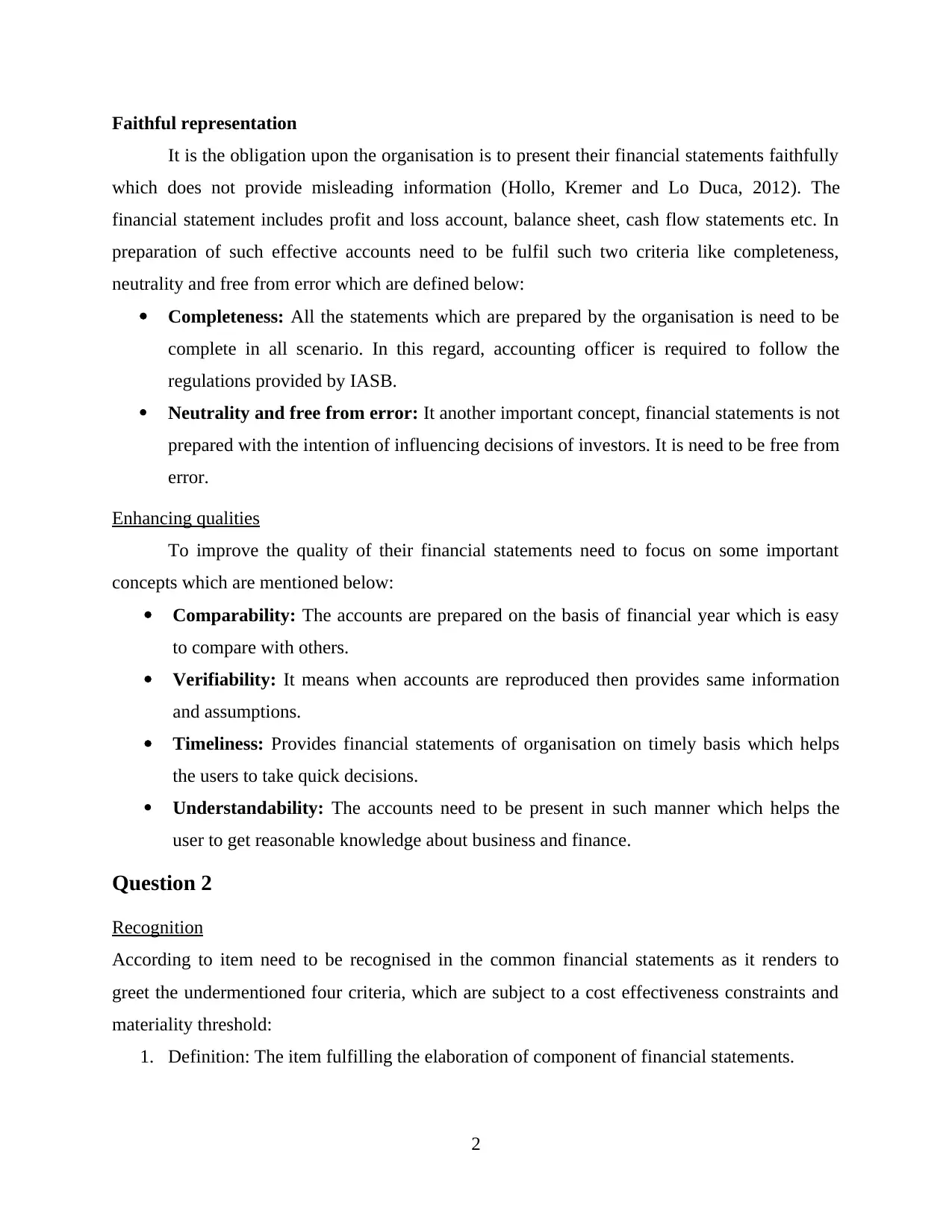
Faithful representation
It is the obligation upon the organisation is to present their financial statements faithfully
which does not provide misleading information (Hollo, Kremer and Lo Duca, 2012). The
financial statement includes profit and loss account, balance sheet, cash flow statements etc. In
preparation of such effective accounts need to be fulfil such two criteria like completeness,
neutrality and free from error which are defined below:
Completeness: All the statements which are prepared by the organisation is need to be
complete in all scenario. In this regard, accounting officer is required to follow the
regulations provided by IASB.
Neutrality and free from error: It another important concept, financial statements is not
prepared with the intention of influencing decisions of investors. It is need to be free from
error.
Enhancing qualities
To improve the quality of their financial statements need to focus on some important
concepts which are mentioned below:
Comparability: The accounts are prepared on the basis of financial year which is easy
to compare with others.
Verifiability: It means when accounts are reproduced then provides same information
and assumptions.
Timeliness: Provides financial statements of organisation on timely basis which helps
the users to take quick decisions.
Understandability: The accounts need to be present in such manner which helps the
user to get reasonable knowledge about business and finance.
Question 2
Recognition
According to item need to be recognised in the common financial statements as it renders to
greet the undermentioned four criteria, which are subject to a cost effectiveness constraints and
materiality threshold:
1. Definition: The item fulfilling the elaboration of component of financial statements.
2
It is the obligation upon the organisation is to present their financial statements faithfully
which does not provide misleading information (Hollo, Kremer and Lo Duca, 2012). The
financial statement includes profit and loss account, balance sheet, cash flow statements etc. In
preparation of such effective accounts need to be fulfil such two criteria like completeness,
neutrality and free from error which are defined below:
Completeness: All the statements which are prepared by the organisation is need to be
complete in all scenario. In this regard, accounting officer is required to follow the
regulations provided by IASB.
Neutrality and free from error: It another important concept, financial statements is not
prepared with the intention of influencing decisions of investors. It is need to be free from
error.
Enhancing qualities
To improve the quality of their financial statements need to focus on some important
concepts which are mentioned below:
Comparability: The accounts are prepared on the basis of financial year which is easy
to compare with others.
Verifiability: It means when accounts are reproduced then provides same information
and assumptions.
Timeliness: Provides financial statements of organisation on timely basis which helps
the users to take quick decisions.
Understandability: The accounts need to be present in such manner which helps the
user to get reasonable knowledge about business and finance.
Question 2
Recognition
According to item need to be recognised in the common financial statements as it renders to
greet the undermentioned four criteria, which are subject to a cost effectiveness constraints and
materiality threshold:
1. Definition: The item fulfilling the elaboration of component of financial statements.
2
Paraphrase This Document
Need a fresh take? Get an instant paraphrase of this document with our AI Paraphraser
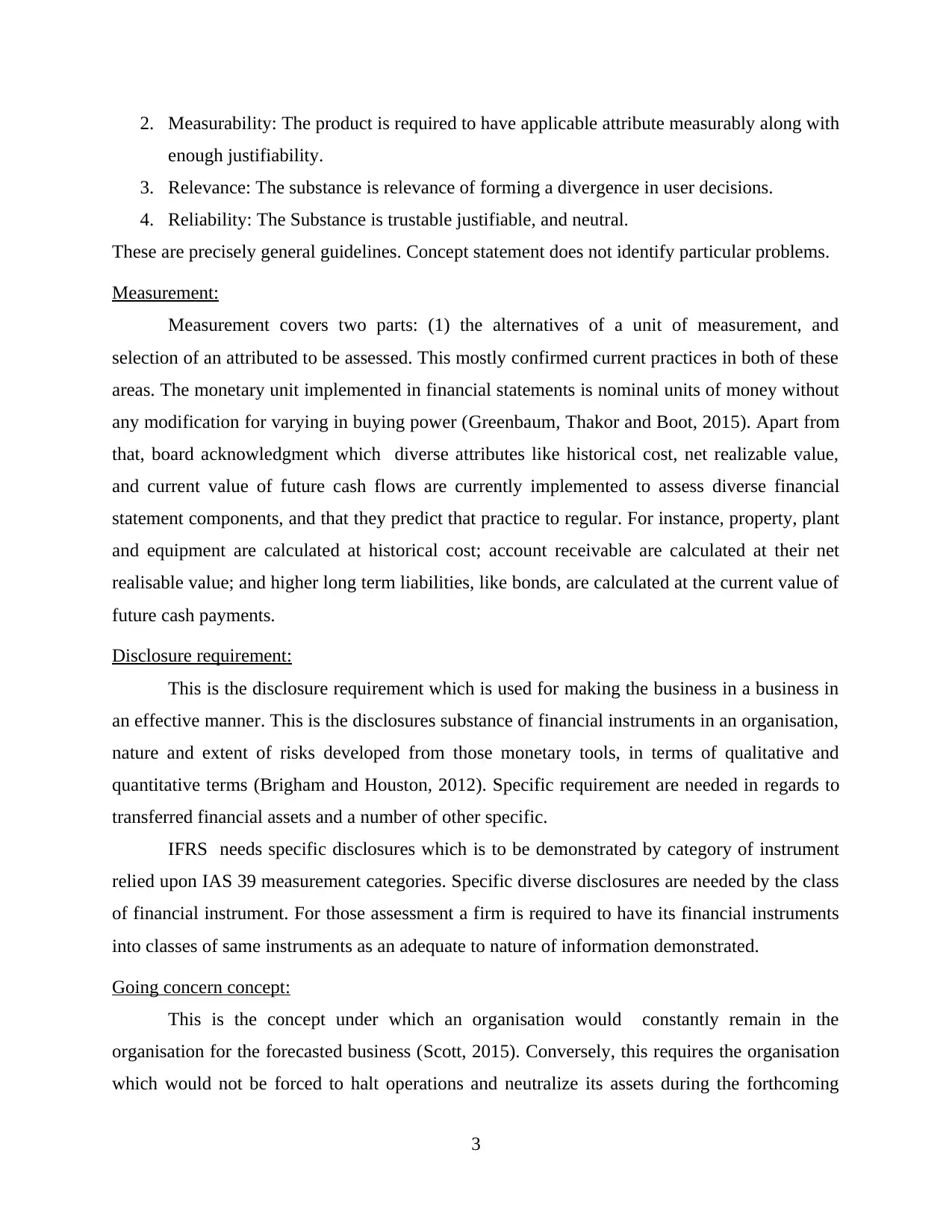
2. Measurability: The product is required to have applicable attribute measurably along with
enough justifiability.
3. Relevance: The substance is relevance of forming a divergence in user decisions.
4. Reliability: The Substance is trustable justifiable, and neutral.
These are precisely general guidelines. Concept statement does not identify particular problems.
Measurement:
Measurement covers two parts: (1) the alternatives of a unit of measurement, and
selection of an attributed to be assessed. This mostly confirmed current practices in both of these
areas. The monetary unit implemented in financial statements is nominal units of money without
any modification for varying in buying power (Greenbaum, Thakor and Boot, 2015). Apart from
that, board acknowledgment which diverse attributes like historical cost, net realizable value,
and current value of future cash flows are currently implemented to assess diverse financial
statement components, and that they predict that practice to regular. For instance, property, plant
and equipment are calculated at historical cost; account receivable are calculated at their net
realisable value; and higher long term liabilities, like bonds, are calculated at the current value of
future cash payments.
Disclosure requirement:
This is the disclosure requirement which is used for making the business in a business in
an effective manner. This is the disclosures substance of financial instruments in an organisation,
nature and extent of risks developed from those monetary tools, in terms of qualitative and
quantitative terms (Brigham and Houston, 2012). Specific requirement are needed in regards to
transferred financial assets and a number of other specific.
IFRS needs specific disclosures which is to be demonstrated by category of instrument
relied upon IAS 39 measurement categories. Specific diverse disclosures are needed by the class
of financial instrument. For those assessment a firm is required to have its financial instruments
into classes of same instruments as an adequate to nature of information demonstrated.
Going concern concept:
This is the concept under which an organisation would constantly remain in the
organisation for the forecasted business (Scott, 2015). Conversely, this requires the organisation
which would not be forced to halt operations and neutralize its assets during the forthcoming
3
enough justifiability.
3. Relevance: The substance is relevance of forming a divergence in user decisions.
4. Reliability: The Substance is trustable justifiable, and neutral.
These are precisely general guidelines. Concept statement does not identify particular problems.
Measurement:
Measurement covers two parts: (1) the alternatives of a unit of measurement, and
selection of an attributed to be assessed. This mostly confirmed current practices in both of these
areas. The monetary unit implemented in financial statements is nominal units of money without
any modification for varying in buying power (Greenbaum, Thakor and Boot, 2015). Apart from
that, board acknowledgment which diverse attributes like historical cost, net realizable value,
and current value of future cash flows are currently implemented to assess diverse financial
statement components, and that they predict that practice to regular. For instance, property, plant
and equipment are calculated at historical cost; account receivable are calculated at their net
realisable value; and higher long term liabilities, like bonds, are calculated at the current value of
future cash payments.
Disclosure requirement:
This is the disclosure requirement which is used for making the business in a business in
an effective manner. This is the disclosures substance of financial instruments in an organisation,
nature and extent of risks developed from those monetary tools, in terms of qualitative and
quantitative terms (Brigham and Houston, 2012). Specific requirement are needed in regards to
transferred financial assets and a number of other specific.
IFRS needs specific disclosures which is to be demonstrated by category of instrument
relied upon IAS 39 measurement categories. Specific diverse disclosures are needed by the class
of financial instrument. For those assessment a firm is required to have its financial instruments
into classes of same instruments as an adequate to nature of information demonstrated.
Going concern concept:
This is the concept under which an organisation would constantly remain in the
organisation for the forecasted business (Scott, 2015). Conversely, this requires the organisation
which would not be forced to halt operations and neutralize its assets during the forthcoming
3
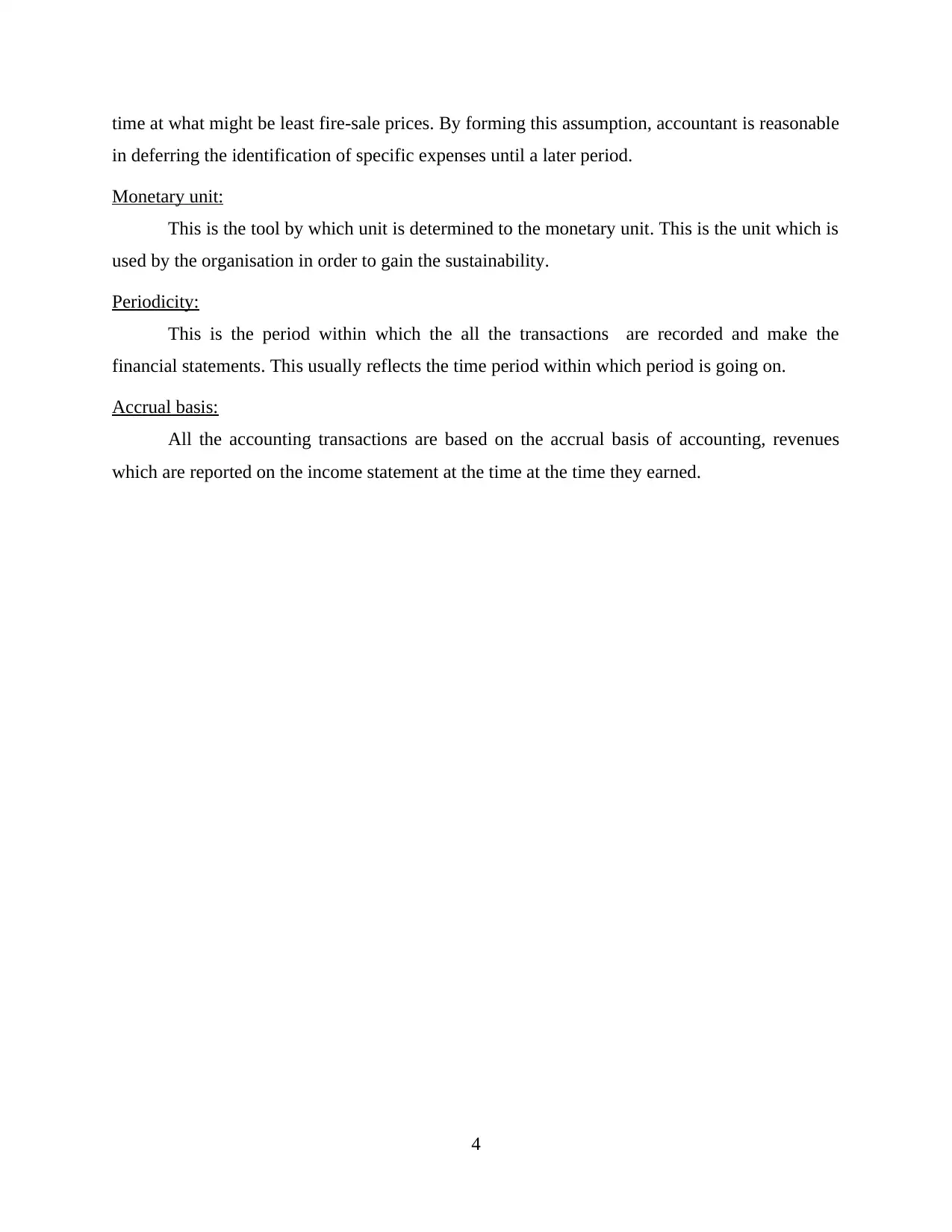
time at what might be least fire-sale prices. By forming this assumption, accountant is reasonable
in deferring the identification of specific expenses until a later period.
Monetary unit:
This is the tool by which unit is determined to the monetary unit. This is the unit which is
used by the organisation in order to gain the sustainability.
Periodicity:
This is the period within which the all the transactions are recorded and make the
financial statements. This usually reflects the time period within which period is going on.
Accrual basis:
All the accounting transactions are based on the accrual basis of accounting, revenues
which are reported on the income statement at the time at the time they earned.
4
in deferring the identification of specific expenses until a later period.
Monetary unit:
This is the tool by which unit is determined to the monetary unit. This is the unit which is
used by the organisation in order to gain the sustainability.
Periodicity:
This is the period within which the all the transactions are recorded and make the
financial statements. This usually reflects the time period within which period is going on.
Accrual basis:
All the accounting transactions are based on the accrual basis of accounting, revenues
which are reported on the income statement at the time at the time they earned.
4
⊘ This is a preview!⊘
Do you want full access?
Subscribe today to unlock all pages.

Trusted by 1+ million students worldwide
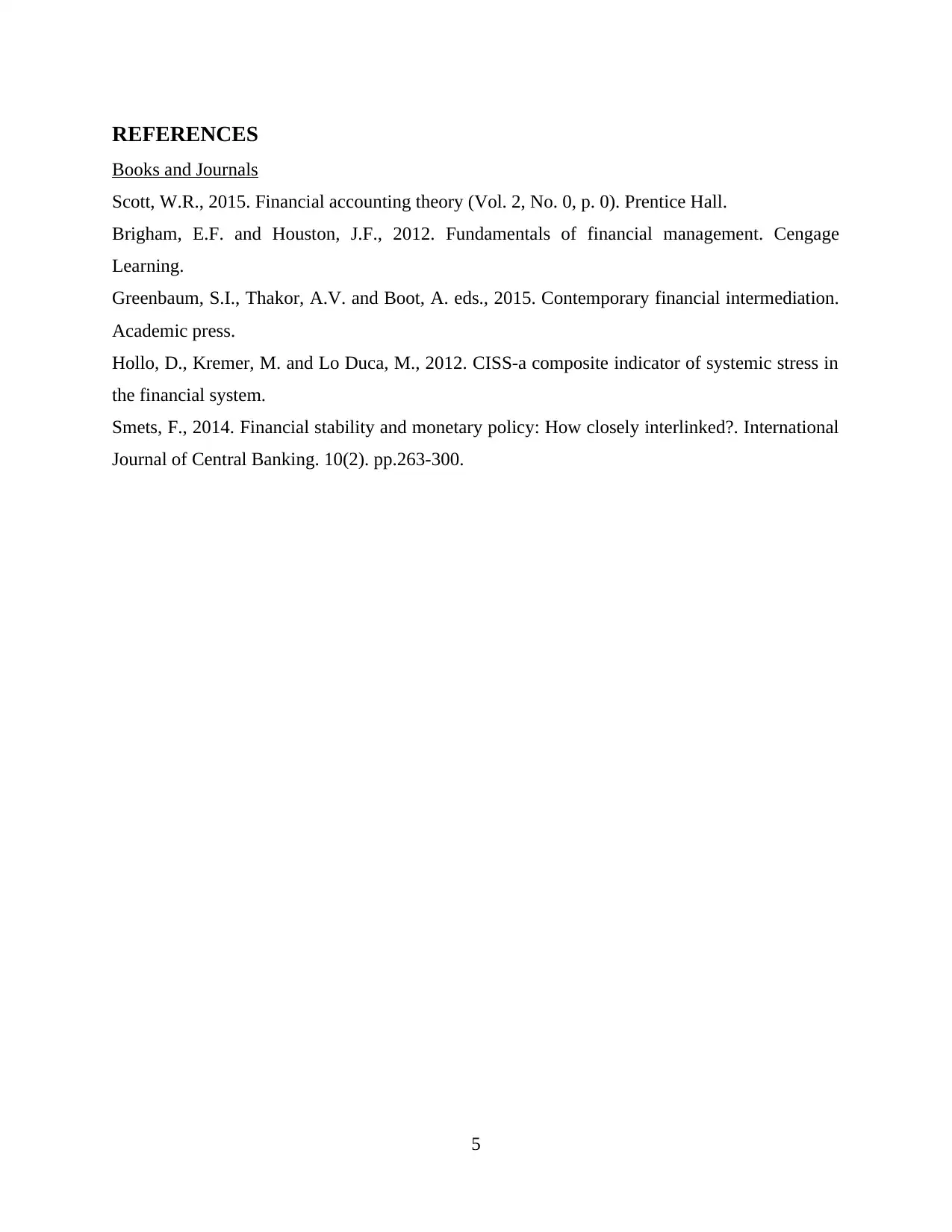
REFERENCES
Books and Journals
Scott, W.R., 2015. Financial accounting theory (Vol. 2, No. 0, p. 0). Prentice Hall.
Brigham, E.F. and Houston, J.F., 2012. Fundamentals of financial management. Cengage
Learning.
Greenbaum, S.I., Thakor, A.V. and Boot, A. eds., 2015. Contemporary financial intermediation.
Academic press.
Hollo, D., Kremer, M. and Lo Duca, M., 2012. CISS-a composite indicator of systemic stress in
the financial system.
Smets, F., 2014. Financial stability and monetary policy: How closely interlinked?. International
Journal of Central Banking. 10(2). pp.263-300.
5
Books and Journals
Scott, W.R., 2015. Financial accounting theory (Vol. 2, No. 0, p. 0). Prentice Hall.
Brigham, E.F. and Houston, J.F., 2012. Fundamentals of financial management. Cengage
Learning.
Greenbaum, S.I., Thakor, A.V. and Boot, A. eds., 2015. Contemporary financial intermediation.
Academic press.
Hollo, D., Kremer, M. and Lo Duca, M., 2012. CISS-a composite indicator of systemic stress in
the financial system.
Smets, F., 2014. Financial stability and monetary policy: How closely interlinked?. International
Journal of Central Banking. 10(2). pp.263-300.
5
1 out of 7
Related Documents
Your All-in-One AI-Powered Toolkit for Academic Success.
+13062052269
info@desklib.com
Available 24*7 on WhatsApp / Email
![[object Object]](/_next/static/media/star-bottom.7253800d.svg)
Unlock your academic potential
Copyright © 2020–2025 A2Z Services. All Rights Reserved. Developed and managed by ZUCOL.





